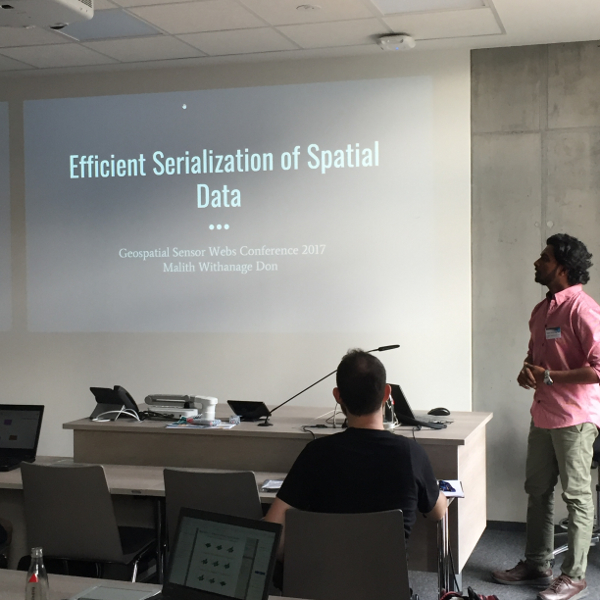This year’s Student Innovation Challenge addresses the topic of analyzing sensor data in the Sensor Web and generating higher level information products. My research topic draws inspiration from smart city applications. To be more specific, IoT sensor web technologies and 3D city models play significant roles in building the smart city. I argued that most of the existing solutions to integrating 3D city models and sensor observations are usually customized and lack interoperability. Therefore, in order to improve the interoperability of smart city models, I conclude that the integration of the IoT sensor service and the 3D city model have to be based on open standards.
Contextual Button – Measuring User Interactions with a Contextual One-Button-Interface
This year’s 52° North Student Innovation Challenge focused on connecting the Internet of Things with Sensor Web technologies. My entry into the challenge was inspired by the Amazon Dash button, a small internet enabled device that allows Amazon customers to order refills for their consumable goods (e.g. razor blades, detergent, etc.). When it is pressed, it connects to Amazon and places an order for the respective item.
What fascinates me is the idea of replacing the process of deliberately going online with a physical action that is directly integrated in the user’s current context. For example, when the user has just used the last of their detergent, they can directly press the button attached to the washing machine to order a refill. The whole interaction takes place in the context of washing clothes.more >
Simple Features for protobuf and others – Final Blog Post
My experience with the GSoC 2017 project “Simple Features for Protobuf and others” came to an end by presenting my results at the Geospatial Sensor Webs Conference 2017. It was really pleasing to see that a majority of the audience was really interested in the project outcome and eager to see it progress in the future.more >
Simple Features for protobuf and others – Mid Term Blog Post
Introduction
The core idea of my GSoC 2017 project “Simple Features for protobuf and others” is to define and implement a serialization API for spatial vector data, which will transparently serialize geometries based on the Simple Feature specification using Protobuf into binary encoding. The Simple Feature Access Specification is a common standard that is widely used in geoinformatics for exchanging spatial features. This serialization API also supports decoding serialized binary data into prefered output models such as JTS and others. Protocol Buffers is used as the primary serialization framework. Other serialization frameworks, such as Avro, are being considered as well. I am currently implementing serializing support for raster data into the API, where it will utilize raster data formats, such as GeoTIFF, and modeling libraries, such as GeoTools.ommon standard that is widely used in geoinformatics for exchanging spatial features. This serialization API also supports decoding serialized binary data into prefered output models such as JTS and others. Protocol Buffers is used as the primary serialization framework. Other serialization frameworks, such as Avro, are being considered as well. I am currently implementing serializing support for raster data into the API, where it will utilize raster data formats, such as GeoTIFF, and modeling libraries, such as GeoTools.
- « Previous Page
- 1
- 2
- 3
- 4
- …
- 12
- Next Page »
